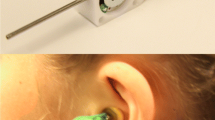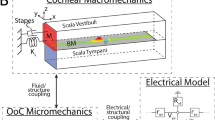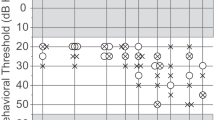Abstract
The behavior of intracochlear distortion products (iDPs) was inferred by interacting a probe tone (f3) with the iDP of interest to produce a “secondary” distortion product otoacoustic emission termed DPOAE2ry. Measures of the DPOAE2ry were then used to deduce the properties of the iDP. This approach was used in alert rabbits and anesthetized gerbils to compare ear-canal 2f1-f2 and 2f2-f1 DPOAE f2/f1 ratio functions, level/phase (L/P) maps, and interference-response areas (IRAs) to their simultaneously collected DPOAE2ry counterparts. These same measures were also collected in a human volunteer to demonstrate similarities with their laboratory animal counterparts and their potential applicability to humans. Results showed that DPOAEs and inferred iDPs evidenced distinct behaviors and properties. That is, DPOAE ratio functions elicited by low-level primaries peaked around an f2/f1 = 1.21 or 1.25, depending on species, while the corresponding inferred iDP ratio functions peaked at f2/f1 ratios of ~1. Additionally, L/P maps showed rapid phase variation with DPOAE frequency (fdp) for the narrow-ratio 2f1-f2 and all 2f2-f1 DPOAEs, while the corresponding DPOAE2ry measures evidenced relatively constant phases. Common features of narrow-ratio DPOAE IRAs, such as large enhancements for interference tones (ITs) presented above f2, were not present in DPOAE2ry IRAs. Finally, based on prior experiments in gerbils, the behavior of the iDP directly measured in intracochlear pressure was compared to the iDP inferred from the DPOAE2ry and found to be similar. Together, these findings are consistent with the notion that under certain conditions, ear-canal DPOAEs provide poor representations of iDPs and thus support a “beamforming” hypothesis. According to this concept, distributed emission components directed toward the ear canal from the f2 and basal to f2 regions can be of differing phases and thus cancel, while these same components directed toward fdp add in phase.





Similar content being viewed by others
Abbreviations
- A/D:
-
Analog-to-digital
- BM:
-
Basilar membrane
- CF:
-
Characteristic frequency
- CP:
-
Compression pressure
- CT:
-
Combination tone
- DP:
-
Distortion product
- DP-gram:
-
DPOAE level as a function of f2 primary-tone frequencies
- DPOAE:
-
Ear-canal distortion product otoacoustic emission
- DPOAE2ry :
-
A secondary DPOAE produced by interacting a DPOAE at 2f1-f2 or 2f2-f1 with a third tone (f3)
- DSP:
-
Digital signal processor
- EQPiDP :
-
Equivalent ear-canal pressure that produces a DPOAE2ry
- f1 and f2 :
-
Lower and upper frequency primary tones, respectively
- f2/f1 :
-
Ratio describing the frequency separation of f1 and f2
- fdp :
-
Distortion product frequency
- iDP:
-
Intracochlear distortion product
- iDP2ry :
-
A secondary intracochlear DP produced by interacting f3 with a DP
- IACUC:
-
Institutional Animal Care and Use Committee
- IRA:
-
Interference-response area
- IRB:
-
Institutional Review Board
- IT:
-
Interference tone
- L/P map:
-
level/phase map
- L1 and L2 :
-
Levels of f1 and f2, respectively
- μm:
-
Micrometer or micron
- NF:
-
Noise floor
- oct:
-
Octave
- OHC:
-
Outer hair cell
- PST :
-
Intracochlear pressure in scala tympani
- PC:
-
Personal computer
- SPL:
-
Sound pressure level
- TW:
-
Traveling wave
- VA:
-
Veterans Affairs
Referrences
Allen JB, Fahey PF (1993) A second cochlear-frequency map that correlates distortion product and neural tuning measurements. J Acoust Soc Am 94:809–816
Avan P, Buki B, Petit C (2013) Auditory distortions: origins and functions. Physiol Rev 93:1563–1619. doi:10.1152/physrev.00029.2012
Cooper NP, Rhode WS (1997) Mechanical responses to two-tone distortion products in the apical and basal turns of the mammalian cochlea. J Neurophysiol 78:261–270
de Boer E, Nuttall AL, Hu N, Zou Y, Zheng J (2005) The Allen-Fahey experiment extended. J Acoust Soc Am 117:1260–1266
Dong W, Olson ES (2005) Two-tone distortion in intracochlear pressure. J Acoust Soc Am 117:2999–3015
Dong W, Olson ES (2006) Middle ear forward and reverse transmission in gerbil. J Neurophysiol 95:2951–2961
Dong W, Olson ES (2008) Supporting evidence for reverse cochlear traveling waves. J Acoust Soc Am 123:222–240. doi:10.1121/1.2816566
Dong W, Olson ES (2013) Detection of cochlear amplification and its activation. Biophys J 105:1067–1078. doi:10.1016/j.bpj.2013.06.049
Fahey PF, Stagner BB, Lonsbury-Martin BL, Martin GK (2000) Nonlinear interactions that could explain distortion product interference response areas. J Acoust Soc Am 108:1786–1802
Fahey PF, Stagner BB, Martin GK (2006) Mechanism for bandpass frequency characteristic in distortion product otoacoustic emission generation. J Acoust Soc Am 119:991–996
Goldstein JL, Buchsbaum G, Furst M (1978) Compatibility between psychophysical and physiological measurements of aural combination tones. J Acoust Soc Am 63:474–485
Harris FP, Lonsbury-Martin BL, Stagner BB, Coats AC, Martin GK (1989) Acoustic distortion products in humans: systematic changes in amplitude as a function of f2/f1 ratio. J Acoust Soc Am 85:220–229
He W, Ren T (2013) Basilar membrane vibration is not involved in the reverse propagation of otoacoustic emissions. Sci Rep 3:1874–1880
Huang S, Olson ES (2011) Auditory nerve excitation via a non-traveling wave mode of basilar membrane motion. J Assoc Res Otolaryngol 12:559–575
Johnson TA, Neely ST, Garner CA, Gorga MP (2006) Influence of primary-level and primary-frequency ratios on human distortion product otoacoustic emissions. J Acoust Soc Am 119:418–428
Knight RD, Kemp DT (2000) Indications of different distortion product otoacoustic emission mechanisms from a detailed f1, f2 area study. J Acoust Soc Am 107:457–473
Knight RD, Kemp DT (2001) Wave and place fixed DPOAE maps of the human ear. J Acoust Soc Am 109:1513–1525
Martin GK, Jassir D, Stagner BB, Whitehead ML, Lonsbury-Martin BL (1998) Locus of generation for the 2f1-f2 vs 2f2-f1 distortion-product otoacoustic emissions in normal-hearing humans revealed by suppression tuning, onset latencies, and amplitude correlations. J Acoust Soc Am 103:1957–1971
Martin GK, Stagner BB, Jassir D, Telischi FF, Lonsbury-Martin BL (1999) Suppression and enhancement of distortion-product otoacoustic emissions by interference tones above f2: I. basic findings in rabbits. Hear Res 136:105–123
Martin GK, Villasuso EI, Stagner BB, Lonsbury-Martin BL (2003) Suppression and enhancement of distortion-product otoacoustic emissions by an interference tone above f2: II. findings in humans. Hear Res 177:111–122
Martin GK, Stagner BB, Fahey PF, Lonsbury-Martin BL (2009) Steep and shallow phase gradient DPOAEs arising basal to the primary tones. J Acoust Soc Am 125:EL85–EL92
Martin GK, Stagner BB, Lonsbury-Martin BL (2010) Evidence for basal distortion-product otoacoustic emission components. J Acoust Soc Am 127:2955–2972
Martin GK, Stagner BB, Chung Y-S, Lonsbury-Martin BL (2011) Characterizing distortion-product otoacoustic emission components across four species. J Acoust Soc Am 129:3090–3103
Martin GK, Stagner BB, Lonsbury-Martin BL (2013) Time-domain demonstration of distributed distortion product otoacoustic emission components. J Acoust Soc Am 134:342–355
Olson ES (1998) Observing middle and inner ear mechanics with novel intracochlear pressure sensors. J Acoust Soc Am 103:3445–3463
Olson ES (1999) Direct measurement of intra-cochlear pressure waves. Nature 402:526–529
Probst R, Lonsbury-Martin BL, Martin GK (1991) A review of otoacoustic emissions. J Acoust Soc Am 89:2027–2067
Ren T (2004) Reverse propagation of sound in the gerbil cochlea. Nat Neurosci 7:333–334
Rhode WS (2007) Distortion product otoacoustic emissions and basilar membrane vibration in the 6–9 kHz region of sensitive chinchilla cochleae. J Acoust Soc Am 122:2725–2737
Rhode WS, Cooper NP (1997) Two-tone suppression and distortion production on the basilar membrane in the hook region of cat and guinea pig cochleae. Hear Res 66:31–45
Robles L, Ruggero MA (2001) Mechanics of the mammalian cochlea. Physiol Rev 81:1305–1352
Robles L, Ruggero MA, Rich NC (1997) Two-tone distortion on the basilar membrane of the chinchilla cochlea. J Neurophysiol 77:2385–2399
Shera CA (2003) Wave interference in the generation of reflection- and distortion-source emissions. In: Gummer AW (ed) Biophysics of the cochlea: molecules to models. World Sci Pr, Singapore, pp 439–453
Shera CA, Guinan JJ (1999) Evoked otoacoustic emissions arise by two fundamentally different mechanisms: a taxonomy for mammalian otoacoustic emissions. J Acoust Soc Am 105:782–798
Shera CA, Guinan JJ (2007) Cochlear traveling-wave amplification, suppression, and beamforming probed using noninvasive calibration of intracochlear distortion sources. J Acoust Soc Am 121:1003–1016
Shera CA, Guinan JJ (2008) Mechanisms of mammalian otoacoustic emission. In: Manley GA, Fay RR, Popper AN (eds) Active processes and otoacoustic emissions. Springer, New York, pp 305–342
Shera CA, Tubis A, Talmadge CL (2006) Four counter-arguments for slow-wave OAEs. In: Nuttall AL, Ren T, Gillespie P, Grosh K, de Boer E (eds) Auditory mechanisms: processes and models. World Sci Pr, Singapore, pp 449–457
Shera CA, Tubis A, Talmadge CL, de Boer E, Fahey PF, Guinan JJ (2007) Allen-Fahey and related experiments support the predominance of cochlear slow-wave otoacoustic emissions. J Acoust Soc Am 121:1564–1575
Stagner BB, Meinke D, Lonsbury-Martin BL, Martin GK (2007) Group delay contour plots derived from DPOAE level/phase maps in normal hearing and noise-damaged humans. Assn Res Otolaryngol Abstr 30:177
Stagner BB, Martin GK, Lonsbury-Martin BL (2014) The intracochlear DP-gram: a noninvasive assay of basilar membrane distortion products in noise-exposed rabbits. Assn Res Otolaryngol Abstr 37:63
Whitehead ML, Lonsbury-Martin BL, Martin GK (1993) Measurement of 2f1-f2 excitation at the distortion-frequency place in the cochlea using ear-canal distortion products. Assn Res Otolaryngol Abstr 16:99
Whitehead ML, McCoy MJ, Lonsbury-Martin BL, Martin GK (1995) Dependence of distortion-product otoacoustic emissions on primary levels in normal and impaired ears: I. Effects of decreasing L2 below L1. J Acoust Soc Am 97:2346–2358
Whitehead ML, Stagner BB, Martin GK, Lonsbury-Martin BL (1996) Visualization of the onset of distortion-product otoacoustic emissions, and measurement of their latency. J Acoust Soc Am 100:1663–1679
Acknowledgments
This work was supported in part by the US National Institutes of Health (National Institute on Deafness and Other Communication Disorders DC000613) and the US Department of Veterans Affairs (VA) (VA/Rehabilitative Research and Development C449R, C6212L). The authors thank Alisa Hetrick for the technical assistance. We also want to thank three anonymous reviewers for their thoughtful comments that undoubtedly improved the manuscript.
Author information
Authors and Affiliations
Corresponding author
Ethics declarations
Conflict of Interest
The authors declare that they have no conflicts of interest.
Rights and permissions
About this article
Cite this article
Martin, G.K., Stagner, B.B., Dong, W. et al. Comparing Distortion Product Otoacoustic Emissions to Intracochlear Distortion Products Inferred from a Noninvasive Assay. JARO 17, 271–287 (2016). https://doi.org/10.1007/s10162-016-0552-1
Received:
Accepted:
Published:
Issue Date:
DOI: https://doi.org/10.1007/s10162-016-0552-1




